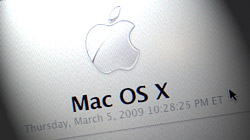Logging into a Mac is pretty straightforward. Luckily, for those of us who like to tinker, the Mac OS X login window offers some flexibility and room for experimentation too. This is the first article of a 4-part series showing the various ways you can customize your Mac’s login screen.
You may not realize it, but the login window on the Mac offers a useful mix of system information that is accessible without even needing to sign in. The reason most folks are probably not aware of this (unless you’re a hard-core user) is because Apple’s done a darn good job of hiding it. Unless you go around randomly clicking things for no reason, it’s unlikely you’d think to find it there on your own. I know I sure didn’t.
The area I’m talking about is right under where it says Mac OS X. You should see your computer’s name (ex. “Ant’s Computer”) in smaller gray text. Clicking on that line of text once will display the version of OS X you’re running (ex. Version 10.5.6). Clicking again will display the build number, then serial number, IP address, network account status, and finally the date and time. Each click reveals a new piece of information about your Mac, which may or may not prove to be useful at some point.
Personally, I don’t need to see the computer name because I already know it’s mine. I think the date and time is the most practical option since it’s relevant for everyday use. The problem with cycling through each of these statuses is that the computer doesn’t remember which one you left it on and will revert back to the computer name next time you log in. With a little bit of Terminal trickery, however, we can change that. Here’s how:
Open Terminal (Applications > Utilities) and copy & paste the following command.
sudo defaults write /Library/Preferences/com.apple.loginwindow AdminHostInfo Time
Now, don’t press anything else quite yet. I always like to explain what Terminal commands consist of, just in case you’re concerned about what exactly you’re getting yourself info.
sudo
Tells Terminal to execute the command through the root user. The root user is the system administrator account.defaults write /Library/Preferences/com.apple.loginwindow
Specifies we’re going to be editing the preferences file called “com.apple.loginwindow” located in the Library directory.AdminHostInfo
The particular setting in the aforementioned preference file we’re looking to change. This determines which piece of system information will be displayed in the login window.Time
Since I have chosen to show the date and time on my login screen, this is the value needed. If you want to show another piece of information, here is the entire list of options you can replace it with: HostName, SystemVersion, SystemBuild, SerialNumber, IPAddress, DSStatus, Time.
When you’ve typed or pasted the final command of your choice, press Enter/Return on your keyboard. You may be prompted for your administrator password, but don’t be alarmed when you start typing and the text cursor doesn’t move. Terminal is registering your keystrokes even though they’re not being shown. Press Enter/Return again and you’ll be good to go. It won’t show a confirmation or any sign that the setting was changed, but rest assured that it was. Log out and back in again to see the changes, or learn how to access your Mac’s login screen without having to log out at all.
One last piece of information… the default value is HostName, so if you ever want to go back to the way it was and show the computer name again, substitute Time with HostName in the command above.
For more Mac login window tricks and tips, check out the other segments of this 4-part series: “Mac login window tricks, Part 2: Add a custom welcome message“, “Mac login window tricks, Part 3: Hide certain user accounts“, and “Mac login window tricks, Part 4: Change default background image“.










March 29th, 2009, 3:38 PM
how can you make it display nothing at all?